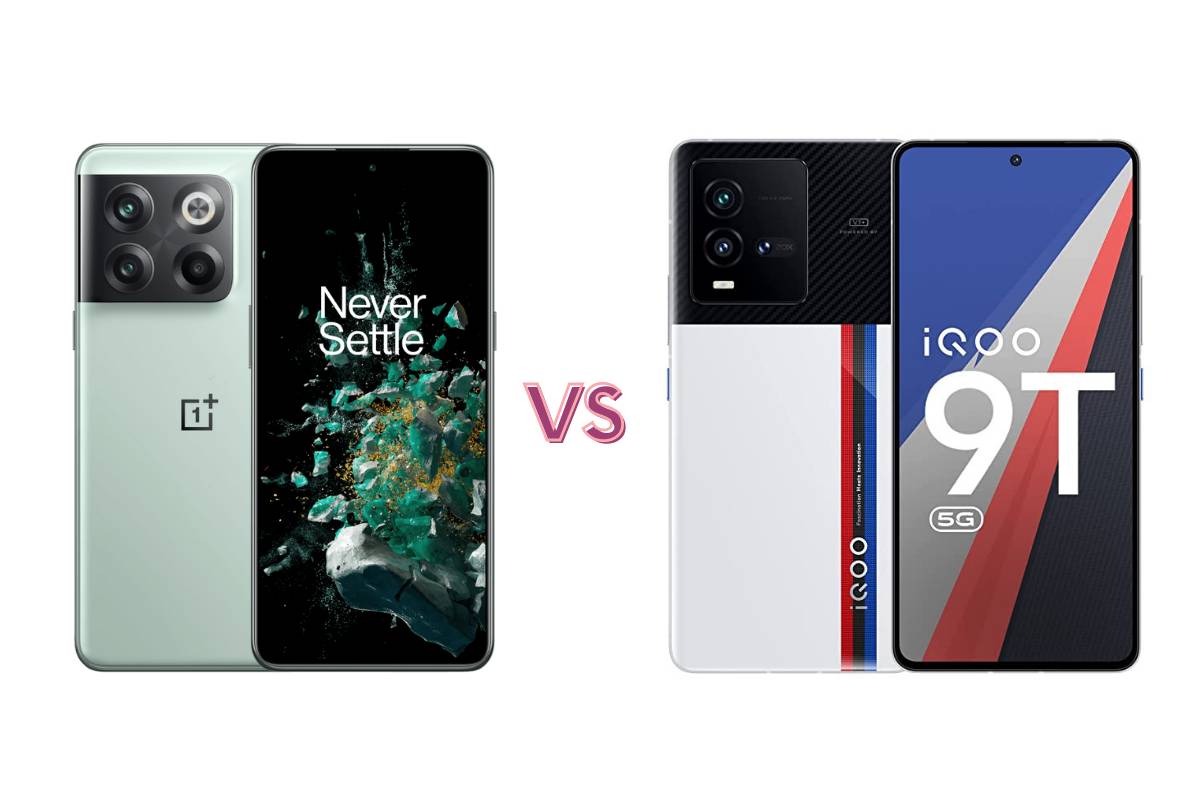In the race to become the next flagship competitor, the recently released OnePlus 10T and iQOO 9T have made their way to India. Both phones are powered by Qualcomm’s most recent Snapdragon 8+ Gen 1 SoC and feature similar characteristics. When comparing devices just on their hardware, the iQOO 9T appears to have a more flexible camera configuration, while the OnePlus 10T has a faster charging rate. In our OnePlus 10T vs iQOO 9T comparison, let’s examine what the two flagships have to offer in more detail.
OnePlus 10T And iQOO 9T: Design
The OnePlus 10T takes cues from its elder sibling, the OnePlus 10 Pro, in terms of design. The phone now sports a flat panel on the front, covering everything from the rear camera island to the curved back. Given the difference between the two phones, it is clear that OnePlus chose to economise by going with an all-plastic design, which they justify with the phone’s 360-degree antenna. A larger battery has taken the place of the company’s venerable Alert Slider, which toggled between Ring, Silent, and Vibrate. The phone lacks a headphone jack and wireless charging as well, but it does have an in-display fingerprint scanner. On the other hand, the iQOO 9T gets a new appearance with a two-tone finish. The phone also features textured glass on the back and a mid-frame made of aluminium, both opulent additions by iQOO. Turning the phone over reveals the large camera module with three lenses arranged in a distinctive manner. The back is designed with carbon fibre, the power button has texture, and the weight distribution is excellent, among other unique characteristics. Unquestionably bigger and more sturdy than the OnePlus 10T is the 9T.
RAM, Storage And Processor
The OnePlus 10T is powered by Qualcomm’s Snapdragon 8+ Gen 1 SoC, Qualcomm’s most recent flagship processor. This new chip promises to produce higher thermal performance and increase overall efficiency by 30% when compared to the previous generation chip. There are three memory options for the phone: the least expensive is the 16GB RAM and 256GB storage option, which comes with 8GB LPDDR5 RAM and 128GB UFS3.1 storage. The Qualcomm Snapdragon 8+ Gen 1 SoC is also used in the iQOO 9T, which has two RAM options. There are two memory options for the phone: the base model, which has 8GB LPDDR5 RAM and 128GB UFS3.1 storage, and the top model, which has 12GB RAM and 256GB storage.
Display
The display is where the two phones slightly diverge. The 6.7-inch E4 10-bit AMOLED screen of the OnePlus 10T has a Full HD+ resolution. This display, which OnePlus refers to as a “Fluid Display,” can dynamically fluctuate between 60, 90, and 120Hz refresh rates. This screen is HDR10+ certified and is identical to the one found in the OnePlus 10R. On the other hand, iQOO has opted for an E5 8-bit AMOLED panel measuring 6.7 inches with Full HD+ resolution. Additionally, the panel utilised here has HDR support for the main OTT apps and can dynamically vary between 60, 90, and 120Hz refresh rates.
Camera
The OnePlus 10T has a triple camera system on the rear camera setup. The same camera configuration has been employed by OnePlus in its mid-range models. An 8MP ultrawide angle lens, a 2MP macro sensor, and a 50MP Sony IMX766 sensor with an f/18 aperture, OIS, and EIS functionality are also included. Selfies are taken with the phone’s 16MP camera. On the other hand, the camera setup on the iQOO 9T is more varied. The back camera setup consists of a 50MP Samsung GN5 sensor with OIS and EIS capabilities, a 13MP ultrawide angle lens, and a 12MP telephoto camera with a dual-LED flash. The selfie camera is 16MP, the same as the one on the OnePlus 10T. By including an in-house created V1+ chip that supports the camera in low-light situations, iQOO also takes the lead in the camera market.
Connectivity
The OnePlus 10T offers dual-band Wi-Fi, dual-band 4G and 5G compatibility, Bluetooth 5.3, GPS, and USB Type-C for data transfer. The support for 11 5G bands for global connectivity and the 360-degree antenna for enhanced connectivity are the highlights of this. The iQOO 9T has dual-band Wi-Fi, dual-band 4G and 5G compatibility, Bluetooth 5.2, GPS, and USB Type-C for data transfer. However, the phone only receives support for 12 5G bands in total, skimping on further 5G bands. Both phones now have in-display fingerprint sensors, but they no longer have a 3.5mm audio port.
